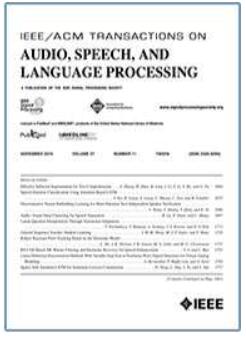CLAPSep: Leveraging Contrastive Pre-Trained Model for Multi-Modal Query-Conditioned Target Sound Extraction
IF 5.1
2区 计算机科学
Q1 ACOUSTICS
IEEE/ACM Transactions on Audio, Speech, and Language Processing
Pub Date : 2024-11-13
DOI:10.1109/TASLP.2024.3497586
引用次数: 0
Abstract
Universal sound separation (USS) aims to extract arbitrary types of sounds from real-world recordings. This can be achieved by language-queried target sound extraction (TSE), which typically consists of two components: a query network that converts user queries into conditional embeddings, and a separation network that extracts the target sound accordingly. Existing methods commonly train models from scratch. As a consequence, substantial data and computational resources are required to make the randomly initialized model comprehend sound events and perform separation accordingly. In this paper, we propose to integrate pre-trained models into TSE models to address the above issue. To be specific, we tailor and adapt the powerful contrastive language-audio pre-trained model (CLAP) for USS, denoted as CLAPSep. CLAPSep also accepts flexible user inputs, taking both positive and negative user prompts of uni- and/or multi-modalities for target sound extraction. These key features of CLAPSep can not only enhance the extraction performance but also improve the versatility of its application. We provide extensive experiments on 5 diverse datasets to demonstrate the superior performance and zero- and few-shot generalizability of our proposed CLAPSep with fast training convergence, surpassing previous methods by a significant margin. Full codes and some audio examples are released for reproduction and evaluation.CLAPSep:利用对比预训练模型进行多模态查询条件下的目标声音提取
通用声音分离(USS)旨在从真实世界的录音中提取任意类型的声音。这可以通过语言查询目标声音提取(TSE)来实现,TSE 通常由两个部分组成:一个是将用户查询转换为条件嵌入的查询网络,另一个是相应提取目标声音的分离网络。现有方法通常从头开始训练模型。因此,要使随机初始化的模型理解声音事件并进行相应的分离,需要大量的数据和计算资源。在本文中,我们建议将预先训练好的模型集成到 TSE 模型中,以解决上述问题。具体来说,我们为 USS 定制并调整了强大的对比语言音频预训练模型(CLAP),称为 CLAPSep;CLAPSep 还接受灵活的用户输入,可接受单模态和/或多模态的正反两方面用户提示来提取目标声音。CLAPSep 的这些关键功能不仅能提高提取性能,还能改善其应用的多样性。我们在 5 个不同的数据集上进行了广泛的实验,证明了我们所提出的 CLAPSep 性能优越,具有零次和少次通用性,训练收敛速度快,大大超过了以前的方法。我们还发布了完整的代码和一些音频示例,以供复制和评估。
本文章由计算机程序翻译,如有差异,请以英文原文为准。
求助全文
约1分钟内获得全文
求助全文
来源期刊

IEEE/ACM Transactions on Audio, Speech, and Language Processing
ACOUSTICS-ENGINEERING, ELECTRICAL & ELECTRONIC
CiteScore
11.30
自引率
11.10%
发文量
217
期刊介绍:
The IEEE/ACM Transactions on Audio, Speech, and Language Processing covers audio, speech and language processing and the sciences that support them. In audio processing: transducers, room acoustics, active sound control, human audition, analysis/synthesis/coding of music, and consumer audio. In speech processing: areas such as speech analysis, synthesis, coding, speech and speaker recognition, speech production and perception, and speech enhancement. In language processing: speech and text analysis, understanding, generation, dialog management, translation, summarization, question answering and document indexing and retrieval, as well as general language modeling.
 求助内容:
求助内容: 应助结果提醒方式:
应助结果提醒方式:


